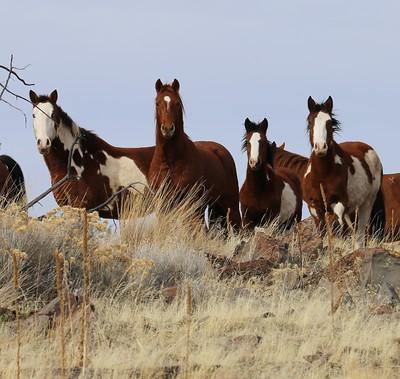BLM to begin wild horse and burro gather in northwest Nevada
Organization:
BLM Office:
Media Contact:
ALTURAS, Calif. – The Bureau of Land Management on Monday, Sept. 27, will begin gathering excess wild horses and burros from public lands managed by its Applegate Field Office in far northwest Nevada.
The BLM plans to gather up to 1,220 wild horses and permanently remove 1,050 from the range in six herd management areas collectively called the Surprise Complex, a name referencing the BLM’s Surprise Field Station in Cedarville. The BLM may release up to 170 animals back to the herd management areas, if needed, to maintain viable populations. Mares released back to the range will be treated with fertility control drugs to slow herd population growth.
There are about 10 burros in the area, and all will be removed, as the herd management plans do not allow for burros.
“Our goal is to maintain healthy wild horses on healthy lands in balance with other authorized range users,” said Craig Drake, manager of the BLM Applegate Field Office in Alturas. “The wild horse populations in the six herd management areas within the Surprise Complex have grown well beyond the population range established in the land use plan. The Wild Free Roaming Horses and Burros Act of 1971, a federal law, requires us to remove from the range animals in excess of the appropriate management levels.”
The BLM will designate public viewing areas at all capture sites and allow public observation daily. Those who wish to view operations should reserve a spot by calling the BLM Public Affairs Officer, Jeff Fontana, at 530-260-0189. Each viewing site can accommodate no more than 10 visitors. In accordance with protocols to prevent the spread of COVID-19, visitors will be asked to maintain six feet of distancing and to wear face masks where distancing is not possible.
On most days, members of the public will meet at 6 a.m., at the Rabbit Traxx gas station and mini mart, 580 Patterson St. (intersection of Patterson and California Route 299) in Cedarville. BLM staff will lead viewers to the observation area. Any changes in meeting times will be noted in a message on the phone line listed above.
Visitors must provide their own transportation in a high-clearance, four-wheel-drive vehicle. They should be sure vehicle tires are sound. They must have a good spare tire and tire changing equipment. Visitors should be prepared for a full day in changing weather conditions ranging from cold mornings to hot afternoons. They should bring plenty of water and food.
The BLM recommends bringing a folding chair, sunscreen, a wide-brimmed hat and sunglasses. There is no shade or restroom facilities at the viewing sites. Most sites will have no cell service. Travel time to some capture sites is over two hours each way on dirt and gravel roads.
An environmental assessment (EA) analyzing impacts of the population management actions was released for public review and comment earlier this year. Comments were addressed and incorporated into the final plan where appropriate. The EA and associated documents are available on the BLM’s ePlanning site at https://eplanning.blm.gov/eplanning-ui/project/2011428/510.
In the upcoming gather, horses will be guided by helicopter to the capture site. Captured horses will be transferred to the BLM’s Litchfield Wild Horse and Burro Corrals near Susanville, and potentially other holding facilities, to be prepared for adoption or sale to the public.
The Surprise Complex covers nearly 397,000 acres in Washoe County, Nev. and Humboldt County, Nev. Based on aerial population surveys and subsequent estimates, the BLM believes there are about 1,300 wild horses in the six HMAs. The appropriate management level is 283 to 496 wild horses. There is a small number of wild burros, but the herd management plans do not provide for wild burro populations there and all wild burros will be removed.
Wild horses and burros are protected on BLM-managed lands by the Wild Free Roaming Horses and Burros Act. The law requires the BLM to determine population levels that allow wild herds to thrive in balance with other range users including wildlife and livestock.
The BLM manages about 245 million acres of public land located primarily in 12 western states, including Alaska, on behalf of the American people. The BLM also administers 700 million acres of sub-surface mineral estate throughout the nation. Our mission is to sustain the health, diversity, and productivity of America’s public lands for the use and enjoyment of present and future generations.

